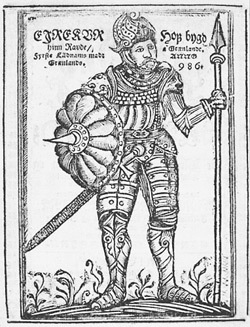Greenland in Depth: If it’s not green, why call it Greenland?
South Greenland from space. (NASA)
Erik the Red, a Norse settler, who is credited with saying that people would go to Greenland “if it had a good name.” Woodcut frontispiece from the 1688 Icelandic publication of Arngrímur Jónsson's Gronlandia (Greenland). (Fiske Icelandic Collection, public domain)
Despite its spring-like name, ice dominates Greenland. The island’s ice sheet—described by American explorer Isaac Hayes as “a vast frozen Sahara”—covers an area the size of Mexico. Roughly 80 percent of Greenland is covered in ice.
Four million years ago, this wasn’t the case. At that time, Greenland was largely free of ice, according to the book “Planet Earth Ice Ages.” Then Earth’s climate shifted, and snow that fell in winter began to remain through the summers without melting. As the snow accumulated from year to year, it compacted of its own weight until it flowed toward both the coast and the center of Greenland, eventually forming a constantly replenished blanket of snow and ice up to two miles thick. Estimates show that 8 percent of the world’s fresh water is locked up in that ice.
So what’s with the name? Most historical descriptions say that the name has roots in Greenland’s colonization by Europeans in the early 10th century. Attribution for the name is often given to Erik the Red, a Norse settler, who is credited with saying that people would go to Greenland “if it had a good name.”
And actually, Greenland would have been greener when the Norse settled, during a time when climate in the North Atlantic region was balmier, known as the Medieval Warm Period, around 800 to 1300. Then it shifted, when climate turned cooler again during the period that followed, the Little Ice Age.
Today, despite its chilly reputation—temperatures can plunge to -30°F (-34°C) in winter and peak at 59°F (15°C) in summer—Greenland is not uninhabited. Eighteen towns dot the perimeter of the island, including Ilulissat and Kangerlussuaq, both stops for the Polar Discovery team en route to our camps. Eighty percent of the island’s approximately 57,000 residents, mostly Danes or native people called Inuit, live in these towns. Another 20 percent reside in smaller settlements. Greenland is a part of Denmark, but has been self-governing since 1979.




